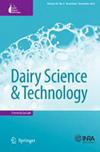Peptidomic Fingerprints of Stored UHT Milk Inoculated with Protease Extracts from Different Pseudomonas Strains Relative to aprX Expression and Visible Spoilage
Q2 Agricultural and Biological Sciences
引用次数: 2
Abstract
Lately, concern about the protease AprX produced by Pseudomonas has increased in the dairy industry due to its ability to survive UHT treatment and spoil UHT milk. Efficient prediction methods for UHT milk spoilage are currently lacking, mainly due to high diversity in proteolytic potential between Pseudomonas strains. The present study aimed to gain more insight into the variability between Pseudomonas strains regarding proteolytic potential by comparing their proteolytic capability with their aprX expression levels and differences in peptide formation. The variability in aprX expression levels in four Pseudomonas strains were related to physical stability, milk proteolysis and peptidomic cleavage patterns of milk proteins in a storage experiment of UHT milk inoculated with protease extracellular extracts and stored for 45 days at 20 °C. A positive relationship was observed between the relative expression of aprX and milk proteolysis during storage, with the strain Pseudomonas panacis DSM 18529 showing the highest level in both parameters. This strain was the only strain to show visual gelation, which occurred after 21 days. The peptide formation analysis showed a similar protein hydrolysis pattern between strains and high hydrolysis of αs1-caseins during long-term spoilage putatively due to the activity of AprX was observed.不同假单胞菌蛋白酶提取物接种UHT储存乳中aprX表达及明显变质的肽组指纹图谱
最近,由于假单胞菌产生的蛋白酶AprX能够在UHT处理中存活并破坏UHT牛奶,因此对乳制品行业的关注有所增加。目前缺乏有效的UHT牛奶变质预测方法,主要是由于假单胞菌菌株之间的蛋白水解潜力存在很大差异。本研究旨在通过比较假单胞菌菌株的蛋白水解能力、aprX表达水平和肽形成差异,进一步了解假单胞菌菌株在蛋白水解潜力方面的差异。在UHT乳中接种蛋白酶胞外提取物,在20°C下保存45 d,研究了4种假单胞菌中aprX表达水平的变化与乳蛋白的物理稳定性、乳蛋白水解和肽裂解模式有关。在贮藏过程中,aprX的相对表达量与牛奶蛋白水解量呈正相关,其中panacis假单胞菌DSM 18529的表达量最高。该菌株是唯一在21天后出现可见凝胶化的菌株。多肽形成分析显示菌株之间具有相似的蛋白质水解模式,αs1-酪蛋白在长期变质过程中被高度水解,这可能与AprX的活性有关。
本文章由计算机程序翻译,如有差异,请以英文原文为准。
求助全文
约1分钟内获得全文
求助全文
来源期刊

Dairy Science & Technology
农林科学-食品科技
CiteScore
2.30
自引率
0.00%
发文量
0
审稿时长
2 months
期刊介绍:
Information not localized
 求助内容:
求助内容: 应助结果提醒方式:
应助结果提醒方式:


